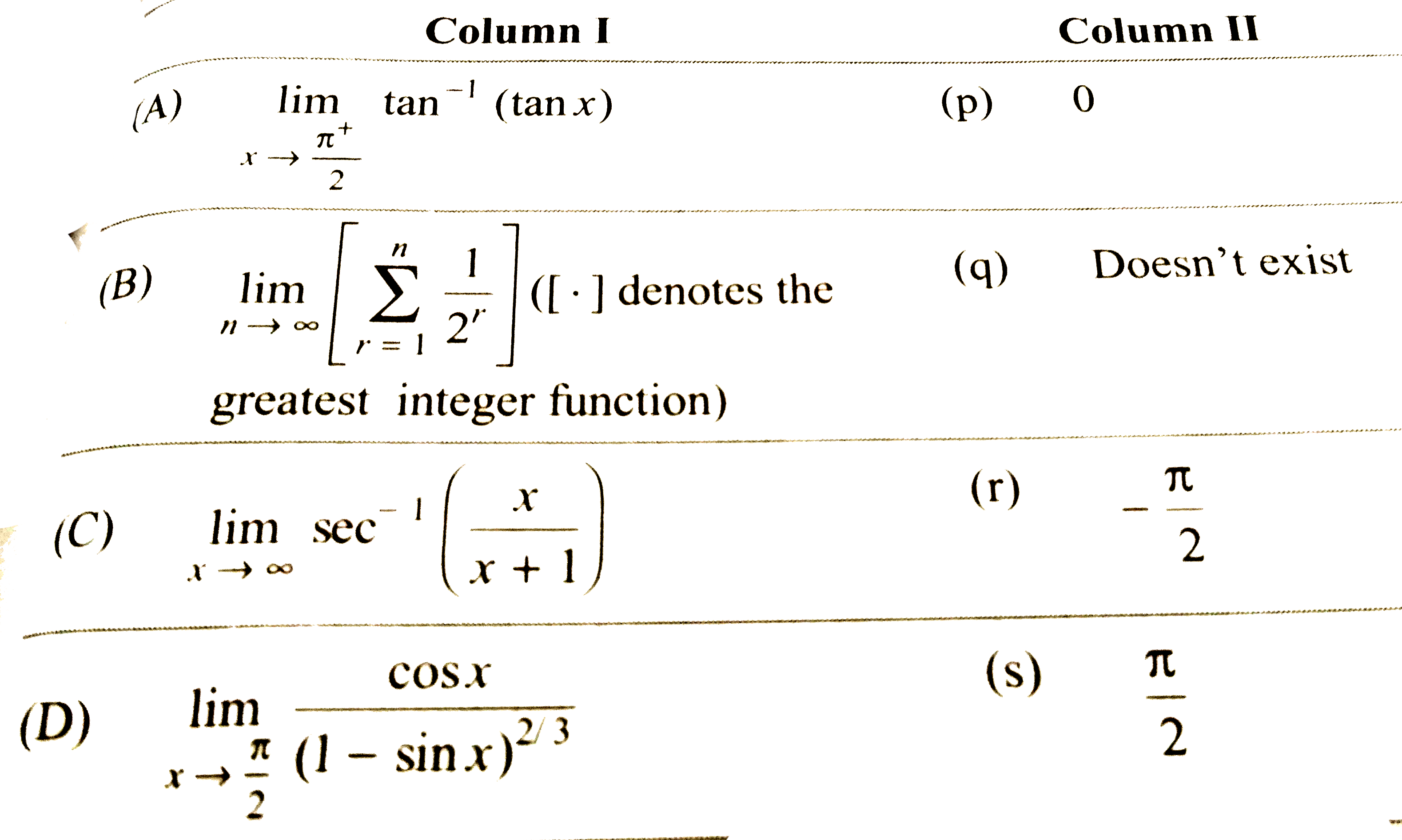does not exist when
where and denotes greatest integer and fractional part of Solution in Punjabi
The correct Answer is:B, C
Step by step video & image solution for lim_(xtoc)f(x) does not exist when where [.] and {.} denotes greatest integer and fractional part of x by Maths experts to help you in doubts & scoring excellent marks in Class 12 exams.
Topper's Solved these Questions
- BOOK - ARIHANT MATHSCHAPTER - LIMITSEXERCISE - Exercise (Passage Based Questions)10videos
LIMITS
- BOOK - ARIHANT MATHSCHAPTER - LIMITSEXERCISE - Exercise (Matching Type Questions)3videos
LIMITS
- BOOK - ARIHANT MATHSCHAPTER - LIMITSEXERCISE - Exercise (Single Option Correct Type Questions)38videos
LIMITS
- BOOK - ARIHANT MATHSCHAPTER - INVERSE TRIGONOMETRIC FUNCTIONSEXERCISE - Exercise (Questions Asked In Previous 13 Years Exam)8videos
INVERSE TRIGONOMETRIC FUNCTIONS
- BOOK - ARIHANT MATHSCHAPTER - LOGARITHM AND THEIR PROPERTIESEXERCISE - Exercise (Questions Asked In Previous 13 Years Exam)4videos
LOGARITHM AND THEIR PROPERTIES
Similar Questions
If limx→af(x)=1 and limx→ag(x)=∞ then limx→a{f(x)}g(x)=elimx→a(f(x)−1)g(x)
limx→0(sinxx)sinxx−sinx is equal to06:06View SolutionMatch the statements of Column I with values of Column II.
 01:34View Solution
01:34View Solutionlimx→0sin(πcos2(tan(sinx)))x2 is equal to
05:09View SolutionIf α=3sin−1(611andβ=3cos−1(49), where the inverse trigonometric functions take only the principal values, then the correct options (s) is (are)
03:57View SolutionIn Which quadrant Point (−2,−3) will be lie.
03:09View SolutionThe range of function f(x)=log_(x)([x]), where [.] and {.} denotes greatest integer and fractional part function respectively
02:39View SolutionIf f(x)=[x^(2)]+sqrt({x}^(2)), where [] and {.} denote the greatest integer and fractional part functions respectively,then
View Solutionlimx→cf(x) does not exist for
wher [.] represent greatest integer function {.} represent fractional part functionView SolutionIf F(x)=sinπ[x]{x} then F(x) is (where {.} denotes fractional part function and [.] denotes greatest integer function and sgn(x) is a signum function)
01:49View SolutionLet f(x)={(cos[x],xge0),(|x|+a,xlt0):} (where [.] denotes greatest integer function) If lim_(xto0)f(x) exists then a is:
01:18View SolutionDomain of f(x)=sin−1([x]{x}), where [⋅] and {⋅} denote greatest integer and fractional parts.
07:16View SolutionThe function f(x)={x}sin(π[x]), where [.] denotes the greatest integer function and {.} is the fraction part function , is discontinuous at
08:48View Solutionf(x)=[x2]−{x}2, where [.] and {.} denote the greatest integer function and the fractional part function , respectively , is
04:14View SolutionThe function f(x)={x}sin(π[x]), where [.] denotes the greatest integer function and {.} is the fractional part function, is discontinuous at
11:54View SolutionThe function f(x)={x}sin(π[x]), where [.] denotes the greatest integer function and {.} is the fraction part function , is discontinuous at
04:47View Solutionf(x)=[x2]−{x}2, where [.] and {.} denote the greatest integer function and the fractional part function , respectively , is
02:50View Solution

